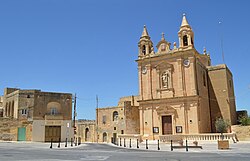This article has multiple issues. Please help improve it or discuss these issues on the talk page . (Learn how and when to remove these messages)
|
Munxar Il-Munxarin | |
|---|---|
 View of Munxar parish church and surroundings | |
 | |
| Coordinates: 36°1′49″N14°14′7″E / 36.03028°N 14.23528°E | |
| Country | |
| Region | |
| District | Gozo and Comino District |
| Borders | Fontana, Kerċem, Sannat, Xewkija |
| Government | |
| • Mayor | Damien Spiteri (PN) |
| Area | |
• Total | 2.8 km2 (1.1 sq mi) |
| Population (March 2023) | |
• Total | 1,707 |
| • Density | 610/km2 (1,600/sq mi) |
| Demonym(s) | Munxari (m), Munxarija (f), Munxarin (pl) |
| Time zone | UTC+1 (CET) |
| • Summer (DST) | UTC+2 (CEST) |
| Postal code | MXR |
| Dialing code | 356 |
| ISO 3166 code | MT-36 |
| Patron saint | St. Paul |
| Website | Official website |
Munxar (Maltese : Il-Munxar) is an administrative unit of Malta, which lies on the southern side of the island of Gozo. As of March 2014, its population was 1,454 people. [1]
Contents
Close to this village, there is Xlendi Bay, a popular tourist resort engulfed in a fjord-like inlet amongst high cliffs. Xlendi Bay is a small fishing village, but is also an ideal bathing and diving resort especially in summer. Otherwise, foreigners and locals enjoy the late spring and early autumn sunsets often captured by artists or keen photographers.
The parish church, a small baroque building built from the typical Maltese stone, is dedicated to St. Paul. It was built between 1914 and 1925 and was consecrated on 18 October 1925. Bishop Giuseppe Pace established it as a parish church on 12 December 1957. As a result, Munxar was the last village in Gozo to become an autonomous parish. The feast officially falls on 10 February which is also a national public holiday; however, the outside festivities are celebrated on the third Sunday of each May.
One of the people of note to have been born and lived in this village is Professor Joseph Aquilina.


